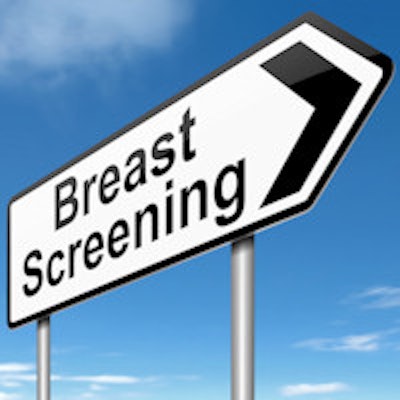
Women who have false-positive results on mammography are at almost twice the risk of breast cancer than women with negative mammography exams, according to a new study published online in Radiology. And it gets worse: Women who have had more than two false-positive exams have nine times the risk of breast cancer compared to those with negative exams.
False-positive mammograms are a point of contention in the ongoing breast cancer screening debate. Critics argue that false positives inflate the cost of screening due to the follow-up exams they prompt -- a position that supports screening every two years rather than annually. But the researchers from Spain believe their study shows that women with false-positive results would actually benefit from more-frequent screening.
"As with other variables, such as family history, age, and breast density, previous screening results may be useful to improve the accuracy of risk prediction models," wrote the group led by Xavier Castells, PhD, from Hospital del Mar Medical Research Institute in Barcelona. "[Yearly] screening may be the preferred pathway in this group, as an exception to the two-year standard interval recommended by the European guidelines."
Framing false positives
For the study, Castells and colleagues analyzed data from more than 500,000 women between the ages of 50 and 69 who underwent screening mammography at least once between 1994 and 2010. Of the total cohort, 76,075 women had false-positive exams, which the researchers defined as any screening mammogram with a BI-RADS score of 3, 4, 5, or 0 (thus requiring further diagnostic tests) (Radiology, February 15, 2016).
The women with false-positive mammography results underwent the following additional exams and procedures:
- Mammography (65.5%)
- Ultrasound (44.2%)
- MRI (4%)
- Fine-needle aspiration (8.4%)
- Core-needle biopsy (4.5%)
- Surgical biopsy (1.1%)
- Vacuum-assisted biopsy (7%)
- Percutaneous excisional biopsy (2%)
Compared to women with negative mammograms, those with false-positive results had a higher overall risk ratio of cancer, as well as a higher risk of screen-detected and interval cancers, the researchers found. The risk increased in women who had calcifications -- whether those calcifications were or were not associated with masses.
| Cancer risk in women with false-positive mammograms | |
| Risk ratio | |
| Overall | 1.84 |
| Screen-detected | 1.77 |
| Interval | 2.01 |
| Calcifications not associated with masses | 2.24 |
| Calcifications associated with masses | 2.73 |
Finally, women in whom mammographic features showed changes in subsequent false-positive results had the highest risk, even though the number of women in this category was small (4.1%). This subset of patients had 30.2% of the breast cancers diagnosed in the false-positive results group, and also had the highest risk ratio in the entire cohort, at 9.13, according to Castells and colleagues.
As breast health experts continue to consider how to create "personalized" or "tailored" screening protocols, taking false-positive results into account may be helpful, the authors wrote.
"Population-based breast cancer screening programs should consider the antecedent of having a false-positive result for recommending yearly follow-up," they concluded.




















